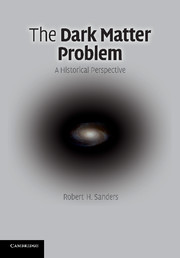Book contents
- Frontmatter
- Contents
- Acknowledgements
- 1 Introduction
- 2 Early history of the dark matter hypothesis
- 3 The stability of disk galaxies: the dark-halo solution
- 4 Direct evidence: extended rotation curves of spiral galaxies
- 5 The maximum-disk: light traces mass
- 6 Cosmology and the birth of astroparticle physics
- 7 Clusters revisited: missing mass found
- 8 CDM confronts galaxy rotation curves
- 9 The new cosmology: introducing dark energy
- 10 An alternative to dark matter: modified Newtonian dynamics
- 11 Seeing dark matter: the theory and practice of detection
- 12 Reflections: a personal point of view
- Appendix Astronomy made simple
- References
- Index
6 - Cosmology and the birth of astroparticle physics
Published online by Cambridge University Press: 05 July 2014
- Frontmatter
- Contents
- Acknowledgements
- 1 Introduction
- 2 Early history of the dark matter hypothesis
- 3 The stability of disk galaxies: the dark-halo solution
- 4 Direct evidence: extended rotation curves of spiral galaxies
- 5 The maximum-disk: light traces mass
- 6 Cosmology and the birth of astroparticle physics
- 7 Clusters revisited: missing mass found
- 8 CDM confronts galaxy rotation curves
- 9 The new cosmology: introducing dark energy
- 10 An alternative to dark matter: modified Newtonian dynamics
- 11 Seeing dark matter: the theory and practice of detection
- 12 Reflections: a personal point of view
- Appendix Astronomy made simple
- References
- Index
Summary
By 1980 the perceived problems of the stability of rotationally supported disk galaxies and the observations of non-declining rotation curves of spiral galaxies had led most astronomers to accept the idea that galaxies are embedded in a dark halo that becomes dynamically more important in the outer regions. There were counter-arguments: Kalnajs, for example, disputed the stability criterion and demonstrated that rotation curves from optical emission lines presented no compelling evidence for dark matter (in so doing, he illuminated the nature of the discrepancy in galaxies, as we have seen). But most people active in this field accepted the presence of a discrepancy and the view that galaxies were darker in the outer regions. Astronomers in general thought in terms of rather conventional dark matter – cold gas, very low-mass stars, failed stars (or super planets), stellar remnants such as cold white dwarfs, neutron stars, or low-mass black holes – i.e., baryonic dark matter.
At about the same time a rather different idea was gaining credence among cosmologists and particle physicists: that the dark matter consists of subatomic particles; non-baryonic dark matter that interacts only weakly with baryons and photons. This was a highly unconventional idea at the time, but now the concept of non-baryonic dark matter has become the paradigm; very few astronomers or cosmologists invoke ordinary, baryonic dark matter. This paradigm shift emerged from cosmological considerations, primarily from the problem of structure formation in a nearly homogeneous Universe combined with observations of the cosmic microwave background radiation – the CMB.
- Type
- Chapter
- Information
- The Dark Matter ProblemA Historical Perspective, pp. 69 - 86Publisher: Cambridge University PressPrint publication year: 2010

